With the population pressure on land and the unmanageable byproducts of our economic growth, new conflicts emerge. How can we better manage this new tension between humans and animals, between conservation and consumption?
A wedding and a suggestion led to an unexpected rendezvous recently. It was an early morning in Bikaner, Rajasthan, when we set off to the Jorbeer Conservation Reserve. The experience was utopian and dystopian in equal measure.
Established more than 100 years ago by Maharaja Ganga Singh, then ruler of Bikaner, as a site suitable for discarding cattle carcasses, far from the palace community, Jorbeer continues to be a graveyard for thousands of animals — camels, goats and sheep, but specially for cows and bulls.
Ironically, in a country that has unwittingly killed most of its vultures, due to the indiscriminate use of diclofenac for cattle health, this 3,000-acre dumping ground is now host to visiting vultures from Siberia, Mongolia and other parts of Central Asia, Europe and the Himalayas.
In the space of an hour, we saw hundreds of them, including white-headed Egyptian vultures, glistening blackcinereous vultures, Eurasian griffons, Himalayan griffons and more. Sometimes maligned as inauspicious, these bald-headed, strong-beaked scavengers have incredible eyesight, a keen sense of smell to tell edible, decomposed flesh from meat that is too rotten to eat, and enough acid in their digestive system to demolish the worst of bacteria. Along with the powerfully beautiful vultures, there were other magnificent migratory raptors — imperial and steppe eagles, tawny eagles and greater spotted eagles. We even watched a lone white stork, one of Europe’s biggest and most recognisable birds, foraging on the ground.
What with all that, and species I don’t get to see in my hometown, Bangalore — the yellow-eyed pigeons and the white-eared bulbuls, the yellow-footed green pigeons and the red collared doves — I was a birder in paradise. Until I tore my eyes away from my binoculars, to see plastic everywhere, as far as the head could turn. Years and years of untreated solid waste curled around trees, some buried below the sandy soil, thanks to gusty desert winds that cover up past sins.
The most heartbreaking scene was at the open wasteland, where cattle bones lay in the winter sun, feral dogs making a feast of the leftovers. All around the carcasses were remains of plastic bags. The huge birds hopped clumsily around ghostly white clumps, searching for flesh. “Why do people come here to throw plastic, all the way from the city,” I asked our birding guide. The answer was shocking.
Most of the plastic came from inside the stomach of the animals. Each cow has at least 30 kg of plastic in her stomach, our guide informed us, his voice resigned and sombre. All over India, cows are feeding on plastic, as they look for edibles in our carelessly discarded garbage. Many veterinarians speak of the harm and pain it causes these animals.
Despite laws on extended producer responsibility, bans on certain plastics and increased budgets for solid-waste management, this problem seems to be running ahead of solutions.
It is now harming every form of life on our land, with microplastics in our food, leaching chemicals into our water, coupled with the stench of burning plastic in the air. I have seen elephant dung in the deep forest laced with strands of plastic. There is no longer any escape from it, anywhere.
This article is not aimed to offer solutions, though there are many organisations across India working on solid-waste management, be it Clean Coonoor in the Nilgiris or Waste Warriors in the Himalayas — that need to be supported. This essay is about the surreal picture emerging in our countryside. Thanks to our millennia-old cultural tradition of respecting our natural heritage, as well as successful recent conservation efforts, we still have incredible biodiversity in this nation. We continue to welcome thousands of migrant species from across the world.
But with the population pressure on land and the unmanageable byproducts of our economic growth, new conflicts emerge. How can we better manage this new tension between humans and animals, between conservation and consumption? Can we spur innovation to solve the complexities arising out of the successes in our economy?
For that, we need to look unflinchingly at life around us — the ants and the bees, the butterflies and the frogs, the elephants and the leopards. We will then begin to understand and then learn to respect, love and nurture such life.
The Jorbeer Conservation Reserve is an amazing place, especially for children to visit, where their eyes can feast on the stunning vultures, nature’s greatest waste warriors that play a crucial role in keeping wildlife and humans healthy.
We are now trying and beginning to succeed by bringing sarkaar and samaaj together, in retrieving indigenous species from the brink. In a shrinking world, we should also welcome those that come from afar, for they do the work nobody else can and rest the bones of India’s most sacred
animal. They deserve better carrion than our plastic waste.
The writer is chairperson, Rohini Nilekani Philanthropies, and author of ‘Samaaj, Sarkaar, Bazaar – a citizen-first approach’.
